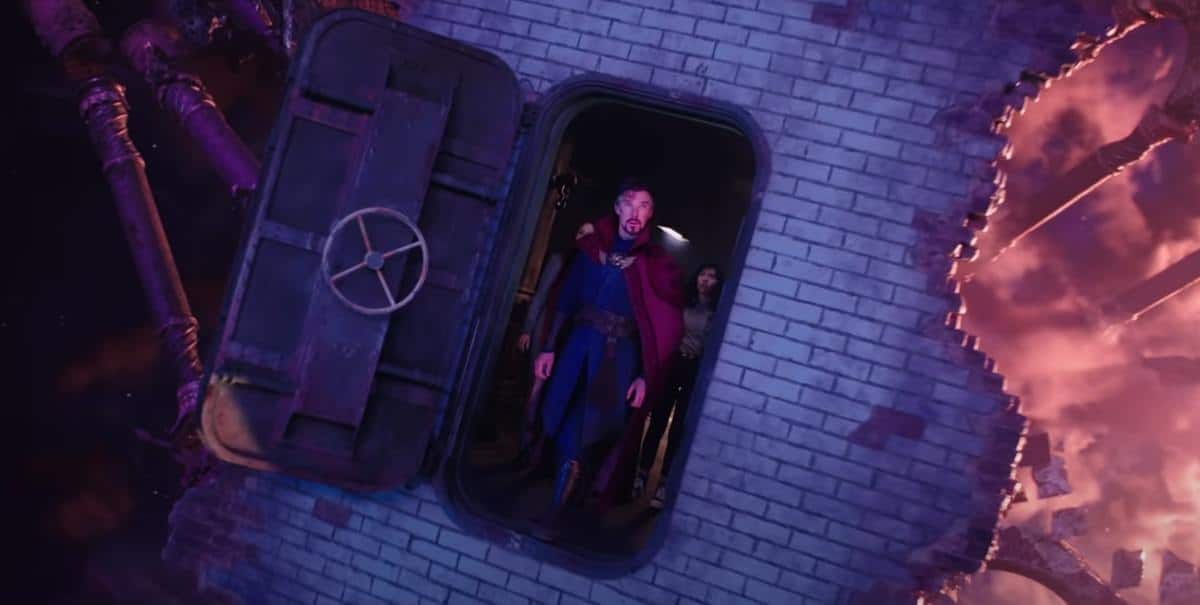Reaction Shots: It’s Morbin Time
Plus a late review of Doctor Strange in the Multiverse of Madness and the Noah Berlatsky Award for Terrible Take
One Hundred Morbillion Dollars
In 2011, a song called Friday by Rebecca Black went viral for all the wrong reasons. Friday was a lyrically confusing song, marred by terrible autotuning, a creepy feature from the record label’s owner, and a poorly edited music video that raises more questions than answers. Black, then 13 at the time, talks about going down on a Friday with her friends, despite initially planning to go to school. This song was meant to be for a few friends and the friends of her parents who set her up for this occasion. The singer earned a lot of derision for an annoyingly catchy song but scored some fans, including Katy Perry, who she appeared in her appropriately named music video Last Friday Night (TGIF). Ten years later, Black released a highly pitched remix of Friday, to show that she was in on the joke. Needless to say, it was even more annoying than the original, but also showed this sense of desperation to be part of the crowd that enjoyed the song, ironically and unironically.
Morbius, the Sony-Marvel film about a Spider-man villain, is the cinematic equivalent of Friday, except it has more talent and unfortunate circumstances. There, Jared Leto is Dr Michael Morbius, a highly-regarded scientist who cures himself of a lifelong blood disease of an experiment that he did in “international waters”. This turned him into a blood-thirsty vampire going head to head with his best friend Milo, who also turns into a blood-thirsty vampire by stealing some of the artificial blood that he invented.
The film received poor reviews and a lukewarm box office reception. Jared Leto’s overacting cement himself in self-parody mode and the sequences where he went Morbin’ mode are so uninspired. Having said that, I don’t think it’s as bad as it turns out. Matt Smith’s performance as Milo is pretty much self-aware of the movie’s ridiculousness, and his dance in front of the mirror is hilarious. It begs the question as to whether Smith would have been better off playing Morbius instead of Leto because he would be far more human.
And yet. There seems to be an ironic fandom for Morbius, going so far as to say that it was the greatest movie ever. Stanley Kubrick came back from the dead to talk about how it was the greatest movie he has seen. Martin Scorsese surrenders all of his cinematic credentials to bow down to the Morb’s greatness. It made a trillion morbillion dollars, as hundreds of thousands of moviegoers went into theatres cheering on Leto utterance of “it’s Morbin’ Time”.
Except he never mentions it. That was basically a meme based on ‘it’s morphin time’, a catchphrase heard in the Power Rangers. But the myth deserves to exist because Morbius is an interesting failure. Not in its content, but in how it became a massive internet meme. There are many reasons why that is the case.
First of all, Leto’s method of acting has become so notorious that Daniel Day-Lewis would tell the guy ‘this isn’t how you do it bro’. Since winning an Oscar for playing a transwoman in Dallas Buyers Club, the actor thought it would be best to go beyond the limits of the character he’s playing, whether it’s the Joker in Suicide Squad or Paolo Gucci in House of Gucci. These roles have less screen time than they demand - the Joker surprisingly has fifteen minutes in presence - but was it necessary for Leto to send dead animals to his cast and colleagues for us to know how disturbed Harley Quinn’s Hot Topic boyfriend is? The same applies to Morbius, a role where he stringently insists that Morbius is sick. The issue is that the main villain is inhuman, not in the sense that he can’t survive like a human being, but that he’s someone I don’t care about. His relationship with any character is stiff. Compare it to Milo, who actually has a solid character arc, but more importantly has identifiable emotions.
The film faced massive delays, as its initial release date was in the fall of 2020, around the time when COVID hit. Then it has so many trailers that hinted a team-up between Morbius and the Vulture, who we first saw in Spider-Man: Homecoming. That it is latching on the recognition of Spider-Man - from the cameos that never fruited into the final product, the references to The Daily Bugle and Venom - does make the film about as pathetic as it seems. Sony Pictures have announced that Morbius will be returning to more than 1000 theatres across America, unaware that all the attention it received was ultimately in part, because of its failure. Even Jared Leto has seen your meme. (And he’s the guy who reprised his Joker and said ‘we live in a society’ only in the Snyder Cut trailer). On its Friday reopening, it received $85,000, making it not the comeback that Sony presumed it would be based on misinterpreting word-of-mouth. You heard of so bad it’s good’, now get ready for ‘it’s so bad you pretend it was good’.
Ironic fandoms for movies are nothing new, but they can evolve in which a movie can be reappraised for its intentions. The Room’s arc went from being a pathetic movie to a movie that everyone can enjoy laughing at, and then a movie that deserved a serious analysis from The New Yorker saying that “it’s actually good?” Same with Showgirls and Southland Tales. Family Guy, decades after its peak, has an ironic following, simply by being memed to death. Will that momentum run out for Morbius after its fifth theatre return? Chances are it will remain a mediocre movie that fell below the bloated expectations of its creators. And that is far worse than being a viral trainwreck.
Review - Doctor Strange in the Multiverse of Madness
Like the fucking loser from that Onion article, I went into Doctor Strange in the Multiverse of Madness all by myself, where the screening is empty. There’s a reason for this. It was a Wednesday matinee screening for a film that came out more than a month ago. But there were four screenings for Doctor Strange 2 when I bought my ticket (it was at a small arthouse theatre and Top Gun Maverick had more than the film because it was the biggest release at that time), which is quite remarkable. To be frank, there seems to be a dominance of the cinematic multiverse with this, Spider-Man: No Way Home and Everything Everywhere All At Once (which is produced by the Russo brothers), not through authentic suffering, but just the ability for the audience to act like every soy face meme that you can think of whenever its hero goes through another dimension.
While I have strong reservations about Marvel and Disney dominating the pop cultural landscape, I do not hate most of the individual entries that consist of the Cinematic Universe. Most of them are fine, if not artless, but I completely understand their mass appeal, even if it pisses off Francis Ford Coppola and Gaspar Noe. And this brings me to my most unpopular opinion: I believe that Doctor Strange is so far, the best MCU entry, despite its hero being its least interesting element. Sure, it doesn’t make add any cutting edge to the storytelling formula we’ve watched dozens of times, but it stands out because of its visual outlook. It is, in its hero’s nature, maximalist and director Scott Derrickson took it as an advantage to make the action sequences far trippier than we should give it credit for.
This is why I was anticipating Multiverse of Madness, because it brought in Marvel (not Cinematic Universe until now) alumni Sam Raimi into the reins to add his flair. Raimi’s Spider-Man, compared to the even more artless and gimmicky approaches to its subsequent entries, was fantastical and humorous in the best way possible. It might as well be the prototype of Dr Strange getting an autograph from a fan after she saved America Chavez - aka Miss America - who has the ability to travel between dimensions by punching open doorways. Unfortunately, Raimi has served what is another visually uninteresting instalment for the franchise, much of it is spent on toothless gimmickry thanks to the likes of No Way Home. It does not simply borrow from No Way Home, but downright plagiarised it, with a thankless amount of cameos from various IPs that would certainly signal the toying of Fox’s own heroes for the next entries.
If you haven’t seen Wandavision like me, then you might be a bit lost on the plot, but Elisabeth Olsen steals the show as Scarlet Witch, enhancing much of Raimi’s horror influences with a bit of mad camp that compensates for the mawkishness behind her backstory. Yet even if I have seen Wandavision, there’s something missing about watching Scarlet Witch going full Eren Yeager on everyone. To paraphrase Calum Marsh, the ratio of madness to mawkish is 70:30 when it should be 90:10. That becomes a problem, when Kevin Feige expects you to indulge in someone, whose origin story (as a second-phase villain, rather than the one you saw in Age of Ultron) is elaborated on a miniseries that already overwhelmed any calculation of consumer demand. But that’s at least preferable to the androgynous heroics of Doctor Strange, whose god-like powers bring nothing special to the table.
You Must Watch This: Force Majeure (2014)
With Triangle of Sadness winning the Palme D’Or at this year’s film festival, it’s time to look back at Ruben Ostlund’s masterful satire of modern gender roles is bleak and hilarious. Its centrepiece is an avalanche almost killing a group of onlookers, including the main family, but the father chooses his phone over them. This creates the main tension between the husband and wife, thanks to a series of detached Kubrick-like compositions, along with Johannes Bah Kuhnke’s incredible performance. His selfishness is unjustifiable to the viewer, but what’s more interesting is how he becomes more pathetic. It was remade in America as Downhill, removing much of the original’s complexity and adding to that, woeful chemistry between Will Ferrell and Julia Louis-Dreyfus where we are asked to identify with one of these actors. I guess Ostlund kind of expected that because the distant perspective expects the viewer to be intelligent about who his characters really are.





